HRM5002D Case Study: Performance Improvement in Health & Social Care
VerifiedAdded on 2023/06/10
|18
|5178
|179
Case Study
AI Summary
This case study delves into performance improvement and management within the health and social care sector, focusing on Arden Mountain Nursing Home. It includes a memorandum for internal directors, evaluating the pros and cons of strategic planning models like the Balanced Scorecard and SWOT analysis, and recommending the Balance Scorecard. The analysis also covers the usefulness of Du Pont analysis for shareholders, including calculations and interpretations of total margin, asset turnover ratio, and equity multiplier, comparing them to industry averages. The study concludes with recommendations for using financial and multidimensional models of performance management in discussions with the management team to enhance overall organizational performance.
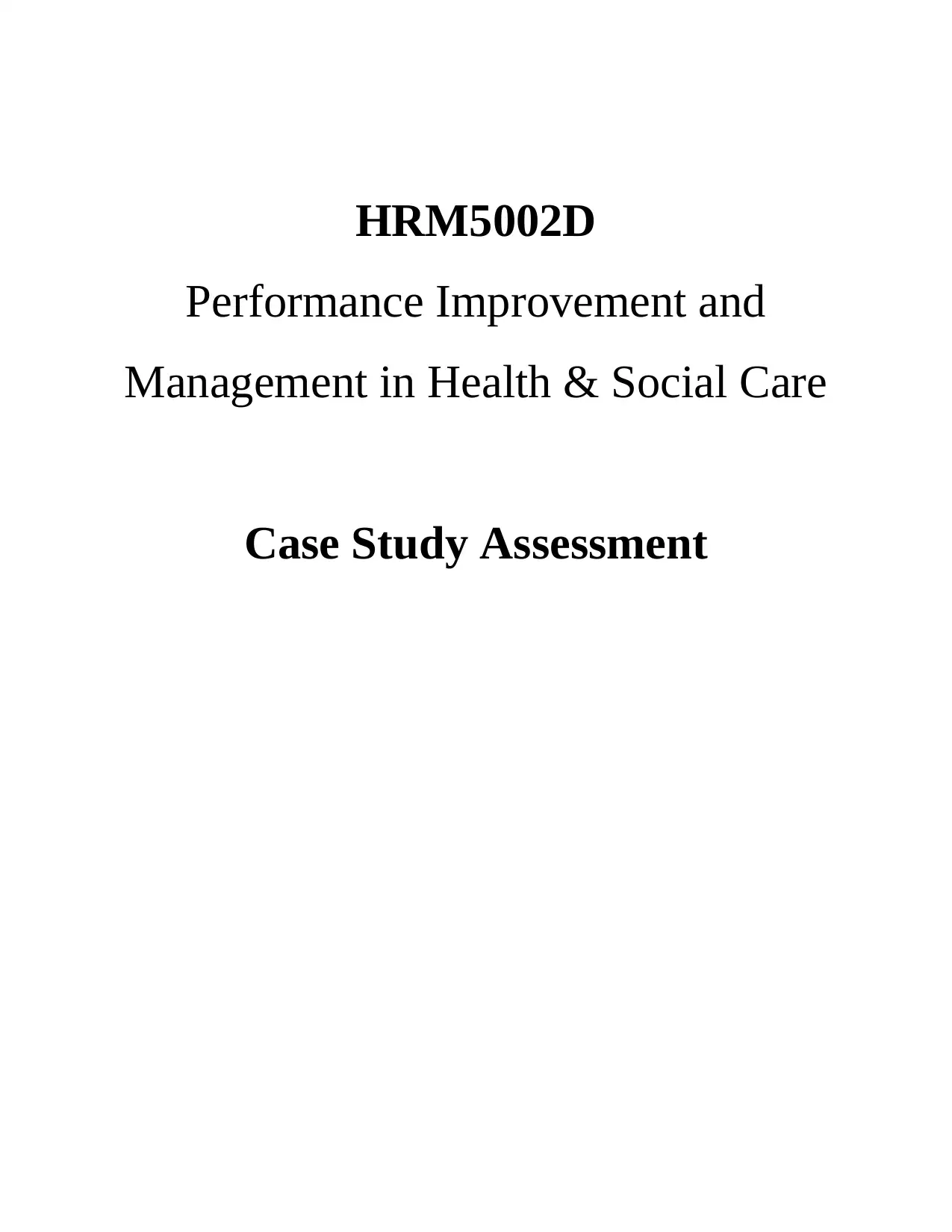
HRM5002D
Performance Improvement and
Management in Health & Social Care
Case Study Assessment
Performance Improvement and
Management in Health & Social Care
Case Study Assessment
Paraphrase This Document
Need a fresh take? Get an instant paraphrase of this document with our AI Paraphraser
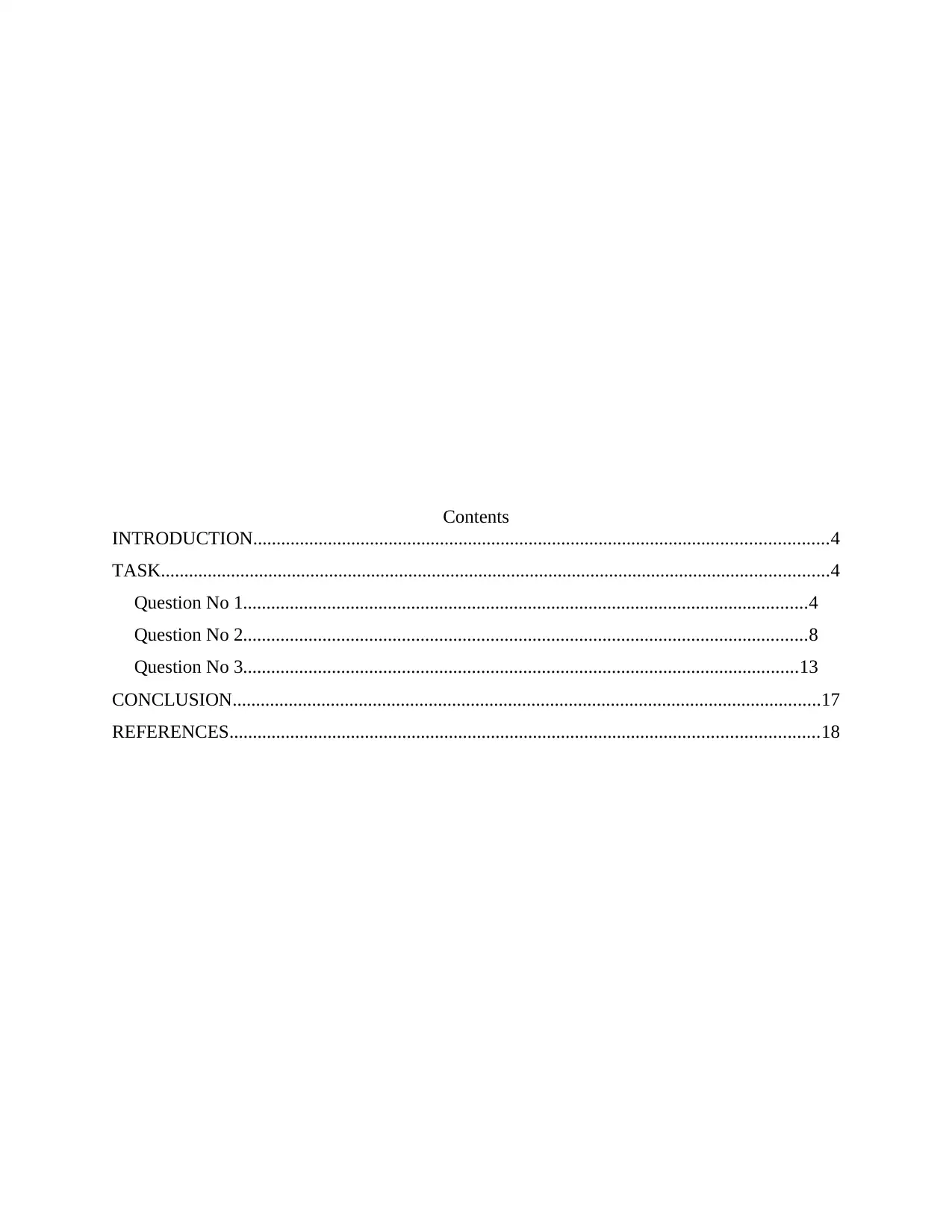
Contents
INTRODUCTION...........................................................................................................................4
TASK...............................................................................................................................................4
Question No 1.........................................................................................................................4
Question No 2.........................................................................................................................8
Question No 3.......................................................................................................................13
CONCLUSION..............................................................................................................................17
REFERENCES..............................................................................................................................18
INTRODUCTION...........................................................................................................................4
TASK...............................................................................................................................................4
Question No 1.........................................................................................................................4
Question No 2.........................................................................................................................8
Question No 3.......................................................................................................................13
CONCLUSION..............................................................................................................................17
REFERENCES..............................................................................................................................18
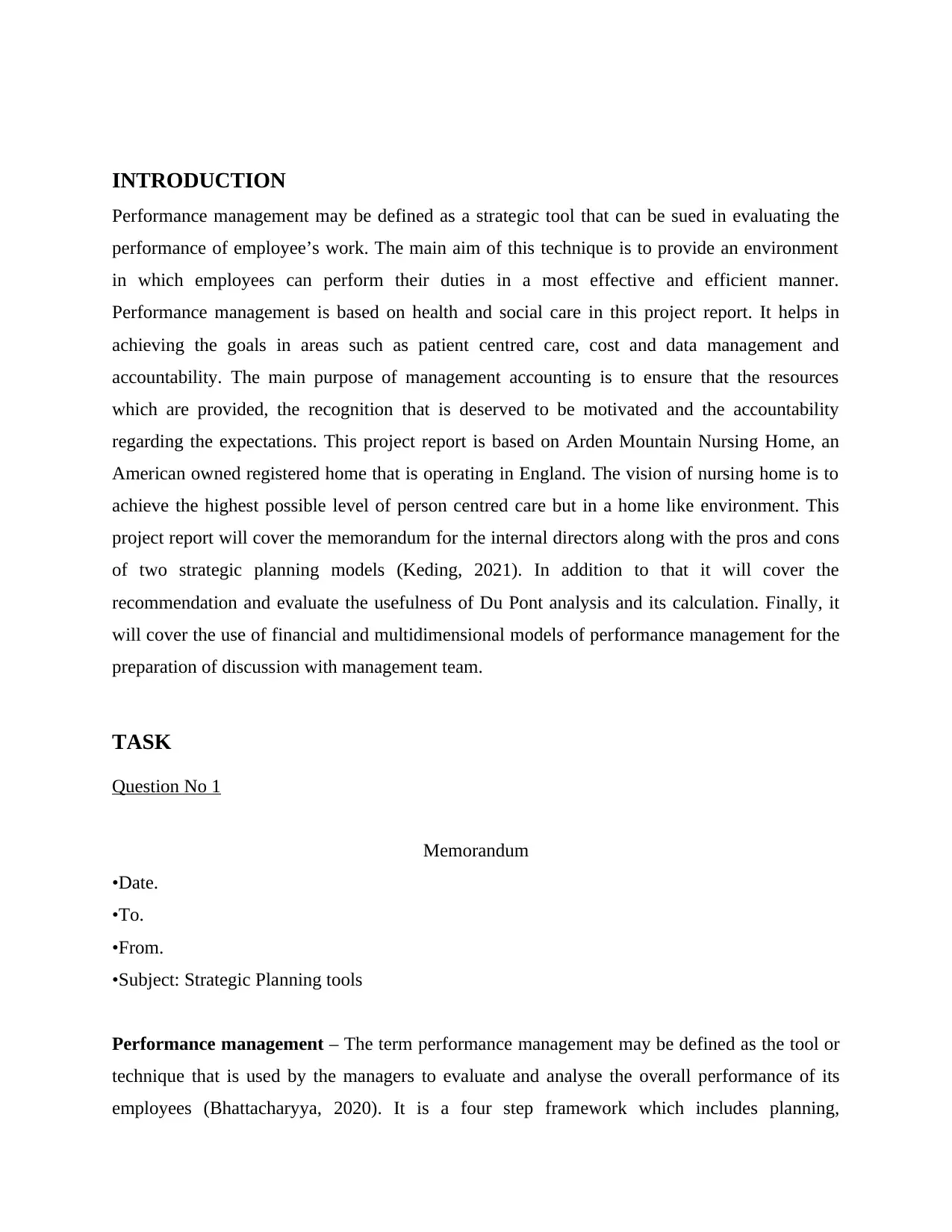
INTRODUCTION
Performance management may be defined as a strategic tool that can be sued in evaluating the
performance of employee’s work. The main aim of this technique is to provide an environment
in which employees can perform their duties in a most effective and efficient manner.
Performance management is based on health and social care in this project report. It helps in
achieving the goals in areas such as patient centred care, cost and data management and
accountability. The main purpose of management accounting is to ensure that the resources
which are provided, the recognition that is deserved to be motivated and the accountability
regarding the expectations. This project report is based on Arden Mountain Nursing Home, an
American owned registered home that is operating in England. The vision of nursing home is to
achieve the highest possible level of person centred care but in a home like environment. This
project report will cover the memorandum for the internal directors along with the pros and cons
of two strategic planning models (Keding, 2021). In addition to that it will cover the
recommendation and evaluate the usefulness of Du Pont analysis and its calculation. Finally, it
will cover the use of financial and multidimensional models of performance management for the
preparation of discussion with management team.
TASK
Question No 1
Memorandum
•Date.
•To.
•From.
•Subject: Strategic Planning tools
Performance management – The term performance management may be defined as the tool or
technique that is used by the managers to evaluate and analyse the overall performance of its
employees (Bhattacharyya, 2020). It is a four step framework which includes planning,
Performance management may be defined as a strategic tool that can be sued in evaluating the
performance of employee’s work. The main aim of this technique is to provide an environment
in which employees can perform their duties in a most effective and efficient manner.
Performance management is based on health and social care in this project report. It helps in
achieving the goals in areas such as patient centred care, cost and data management and
accountability. The main purpose of management accounting is to ensure that the resources
which are provided, the recognition that is deserved to be motivated and the accountability
regarding the expectations. This project report is based on Arden Mountain Nursing Home, an
American owned registered home that is operating in England. The vision of nursing home is to
achieve the highest possible level of person centred care but in a home like environment. This
project report will cover the memorandum for the internal directors along with the pros and cons
of two strategic planning models (Keding, 2021). In addition to that it will cover the
recommendation and evaluate the usefulness of Du Pont analysis and its calculation. Finally, it
will cover the use of financial and multidimensional models of performance management for the
preparation of discussion with management team.
TASK
Question No 1
Memorandum
•Date.
•To.
•From.
•Subject: Strategic Planning tools
Performance management – The term performance management may be defined as the tool or
technique that is used by the managers to evaluate and analyse the overall performance of its
employees (Bhattacharyya, 2020). It is a four step framework which includes planning,
⊘ This is a preview!⊘
Do you want full access?
Subscribe today to unlock all pages.

Trusted by 1+ million students worldwide
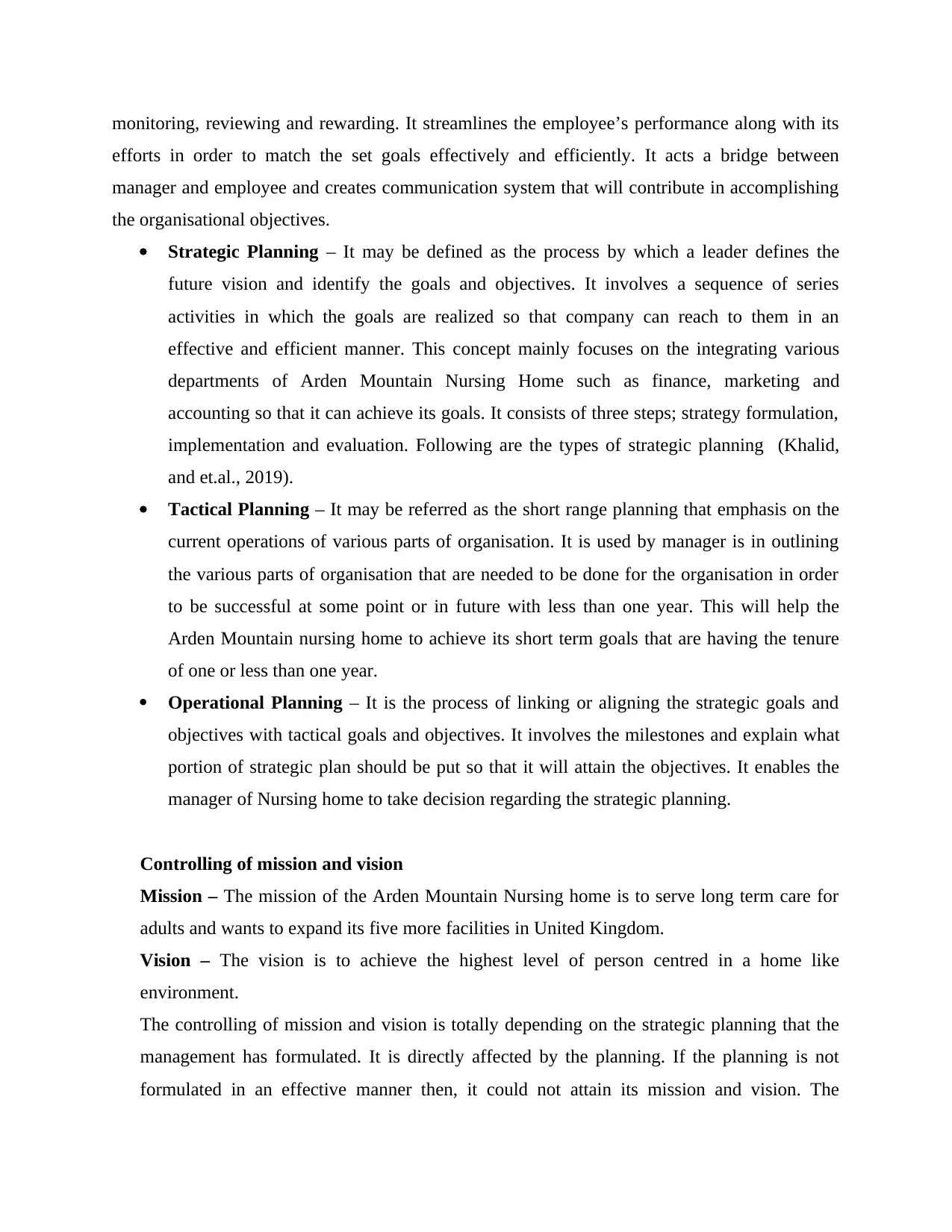
monitoring, reviewing and rewarding. It streamlines the employee’s performance along with its
efforts in order to match the set goals effectively and efficiently. It acts a bridge between
manager and employee and creates communication system that will contribute in accomplishing
the organisational objectives.
Strategic Planning – It may be defined as the process by which a leader defines the
future vision and identify the goals and objectives. It involves a sequence of series
activities in which the goals are realized so that company can reach to them in an
effective and efficient manner. This concept mainly focuses on the integrating various
departments of Arden Mountain Nursing Home such as finance, marketing and
accounting so that it can achieve its goals. It consists of three steps; strategy formulation,
implementation and evaluation. Following are the types of strategic planning (Khalid,
and et.al., 2019).
Tactical Planning – It may be referred as the short range planning that emphasis on the
current operations of various parts of organisation. It is used by manager is in outlining
the various parts of organisation that are needed to be done for the organisation in order
to be successful at some point or in future with less than one year. This will help the
Arden Mountain nursing home to achieve its short term goals that are having the tenure
of one or less than one year.
Operational Planning – It is the process of linking or aligning the strategic goals and
objectives with tactical goals and objectives. It involves the milestones and explain what
portion of strategic plan should be put so that it will attain the objectives. It enables the
manager of Nursing home to take decision regarding the strategic planning.
Controlling of mission and vision
Mission – The mission of the Arden Mountain Nursing home is to serve long term care for
adults and wants to expand its five more facilities in United Kingdom.
Vision – The vision is to achieve the highest level of person centred in a home like
environment.
The controlling of mission and vision is totally depending on the strategic planning that the
management has formulated. It is directly affected by the planning. If the planning is not
formulated in an effective manner then, it could not attain its mission and vision. The
efforts in order to match the set goals effectively and efficiently. It acts a bridge between
manager and employee and creates communication system that will contribute in accomplishing
the organisational objectives.
Strategic Planning – It may be defined as the process by which a leader defines the
future vision and identify the goals and objectives. It involves a sequence of series
activities in which the goals are realized so that company can reach to them in an
effective and efficient manner. This concept mainly focuses on the integrating various
departments of Arden Mountain Nursing Home such as finance, marketing and
accounting so that it can achieve its goals. It consists of three steps; strategy formulation,
implementation and evaluation. Following are the types of strategic planning (Khalid,
and et.al., 2019).
Tactical Planning – It may be referred as the short range planning that emphasis on the
current operations of various parts of organisation. It is used by manager is in outlining
the various parts of organisation that are needed to be done for the organisation in order
to be successful at some point or in future with less than one year. This will help the
Arden Mountain nursing home to achieve its short term goals that are having the tenure
of one or less than one year.
Operational Planning – It is the process of linking or aligning the strategic goals and
objectives with tactical goals and objectives. It involves the milestones and explain what
portion of strategic plan should be put so that it will attain the objectives. It enables the
manager of Nursing home to take decision regarding the strategic planning.
Controlling of mission and vision
Mission – The mission of the Arden Mountain Nursing home is to serve long term care for
adults and wants to expand its five more facilities in United Kingdom.
Vision – The vision is to achieve the highest level of person centred in a home like
environment.
The controlling of mission and vision is totally depending on the strategic planning that the
management has formulated. It is directly affected by the planning. If the planning is not
formulated in an effective manner then, it could not attain its mission and vision. The
Paraphrase This Document
Need a fresh take? Get an instant paraphrase of this document with our AI Paraphraser
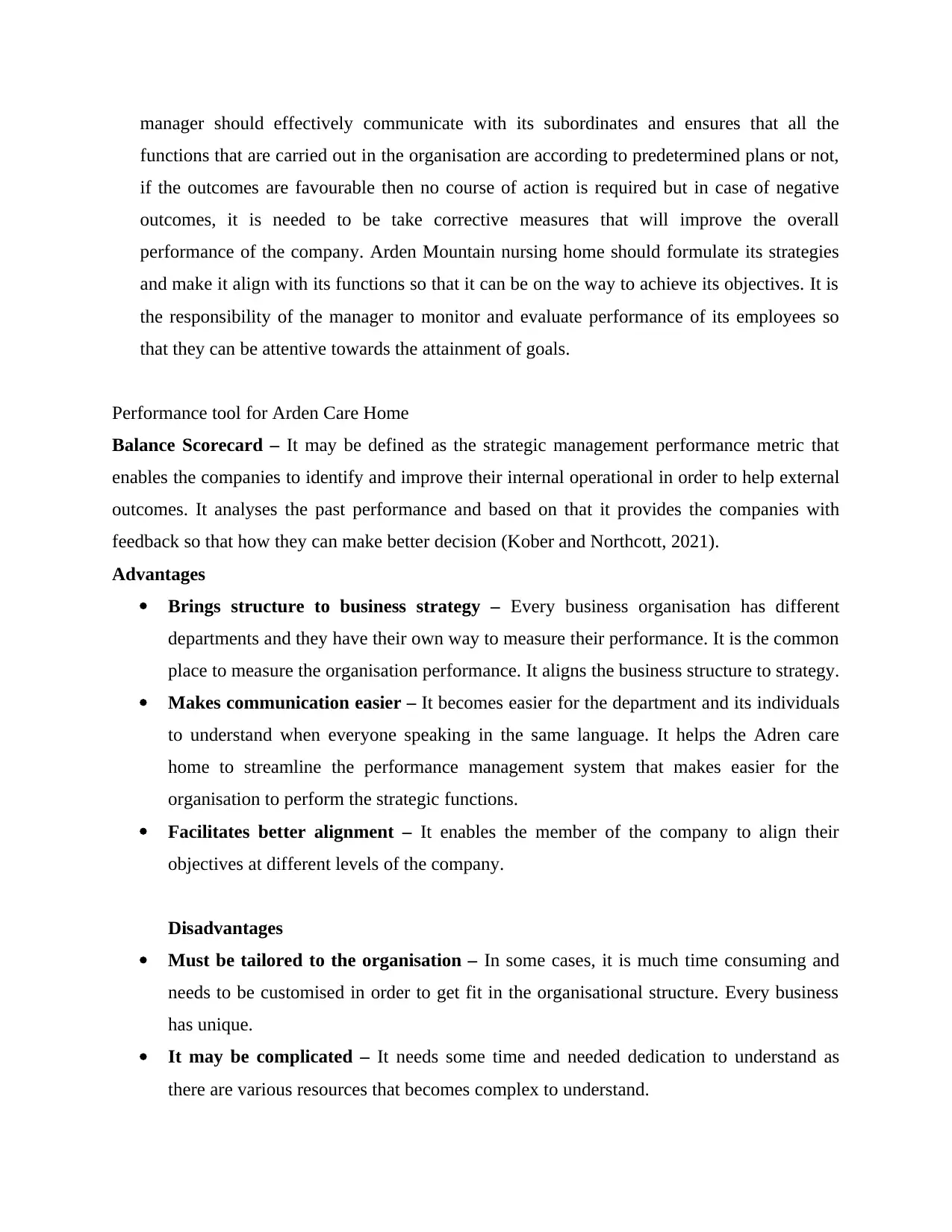
manager should effectively communicate with its subordinates and ensures that all the
functions that are carried out in the organisation are according to predetermined plans or not,
if the outcomes are favourable then no course of action is required but in case of negative
outcomes, it is needed to be take corrective measures that will improve the overall
performance of the company. Arden Mountain nursing home should formulate its strategies
and make it align with its functions so that it can be on the way to achieve its objectives. It is
the responsibility of the manager to monitor and evaluate performance of its employees so
that they can be attentive towards the attainment of goals.
Performance tool for Arden Care Home
Balance Scorecard – It may be defined as the strategic management performance metric that
enables the companies to identify and improve their internal operational in order to help external
outcomes. It analyses the past performance and based on that it provides the companies with
feedback so that how they can make better decision (Kober and Northcott, 2021).
Advantages
Brings structure to business strategy – Every business organisation has different
departments and they have their own way to measure their performance. It is the common
place to measure the organisation performance. It aligns the business structure to strategy.
Makes communication easier – It becomes easier for the department and its individuals
to understand when everyone speaking in the same language. It helps the Adren care
home to streamline the performance management system that makes easier for the
organisation to perform the strategic functions.
Facilitates better alignment – It enables the member of the company to align their
objectives at different levels of the company.
Disadvantages
Must be tailored to the organisation – In some cases, it is much time consuming and
needs to be customised in order to get fit in the organisational structure. Every business
has unique.
It may be complicated – It needs some time and needed dedication to understand as
there are various resources that becomes complex to understand.
functions that are carried out in the organisation are according to predetermined plans or not,
if the outcomes are favourable then no course of action is required but in case of negative
outcomes, it is needed to be take corrective measures that will improve the overall
performance of the company. Arden Mountain nursing home should formulate its strategies
and make it align with its functions so that it can be on the way to achieve its objectives. It is
the responsibility of the manager to monitor and evaluate performance of its employees so
that they can be attentive towards the attainment of goals.
Performance tool for Arden Care Home
Balance Scorecard – It may be defined as the strategic management performance metric that
enables the companies to identify and improve their internal operational in order to help external
outcomes. It analyses the past performance and based on that it provides the companies with
feedback so that how they can make better decision (Kober and Northcott, 2021).
Advantages
Brings structure to business strategy – Every business organisation has different
departments and they have their own way to measure their performance. It is the common
place to measure the organisation performance. It aligns the business structure to strategy.
Makes communication easier – It becomes easier for the department and its individuals
to understand when everyone speaking in the same language. It helps the Adren care
home to streamline the performance management system that makes easier for the
organisation to perform the strategic functions.
Facilitates better alignment – It enables the member of the company to align their
objectives at different levels of the company.
Disadvantages
Must be tailored to the organisation – In some cases, it is much time consuming and
needs to be customised in order to get fit in the organisational structure. Every business
has unique.
It may be complicated – It needs some time and needed dedication to understand as
there are various resources that becomes complex to understand.
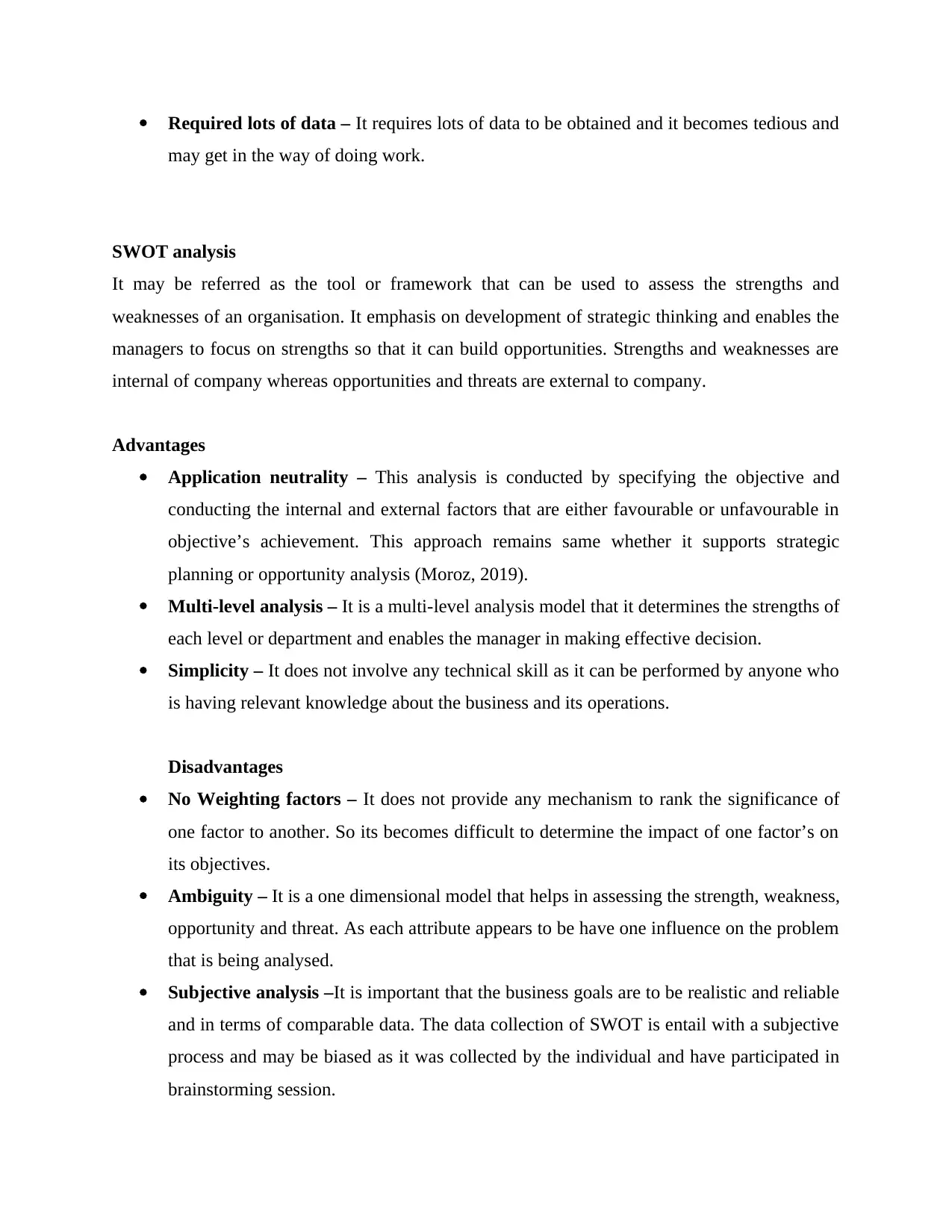
Required lots of data – It requires lots of data to be obtained and it becomes tedious and
may get in the way of doing work.
SWOT analysis
It may be referred as the tool or framework that can be used to assess the strengths and
weaknesses of an organisation. It emphasis on development of strategic thinking and enables the
managers to focus on strengths so that it can build opportunities. Strengths and weaknesses are
internal of company whereas opportunities and threats are external to company.
Advantages
Application neutrality – This analysis is conducted by specifying the objective and
conducting the internal and external factors that are either favourable or unfavourable in
objective’s achievement. This approach remains same whether it supports strategic
planning or opportunity analysis (Moroz, 2019).
Multi-level analysis – It is a multi-level analysis model that it determines the strengths of
each level or department and enables the manager in making effective decision.
Simplicity – It does not involve any technical skill as it can be performed by anyone who
is having relevant knowledge about the business and its operations.
Disadvantages
No Weighting factors – It does not provide any mechanism to rank the significance of
one factor to another. So its becomes difficult to determine the impact of one factor’s on
its objectives.
Ambiguity – It is a one dimensional model that helps in assessing the strength, weakness,
opportunity and threat. As each attribute appears to be have one influence on the problem
that is being analysed.
Subjective analysis –It is important that the business goals are to be realistic and reliable
and in terms of comparable data. The data collection of SWOT is entail with a subjective
process and may be biased as it was collected by the individual and have participated in
brainstorming session.
may get in the way of doing work.
SWOT analysis
It may be referred as the tool or framework that can be used to assess the strengths and
weaknesses of an organisation. It emphasis on development of strategic thinking and enables the
managers to focus on strengths so that it can build opportunities. Strengths and weaknesses are
internal of company whereas opportunities and threats are external to company.
Advantages
Application neutrality – This analysis is conducted by specifying the objective and
conducting the internal and external factors that are either favourable or unfavourable in
objective’s achievement. This approach remains same whether it supports strategic
planning or opportunity analysis (Moroz, 2019).
Multi-level analysis – It is a multi-level analysis model that it determines the strengths of
each level or department and enables the manager in making effective decision.
Simplicity – It does not involve any technical skill as it can be performed by anyone who
is having relevant knowledge about the business and its operations.
Disadvantages
No Weighting factors – It does not provide any mechanism to rank the significance of
one factor to another. So its becomes difficult to determine the impact of one factor’s on
its objectives.
Ambiguity – It is a one dimensional model that helps in assessing the strength, weakness,
opportunity and threat. As each attribute appears to be have one influence on the problem
that is being analysed.
Subjective analysis –It is important that the business goals are to be realistic and reliable
and in terms of comparable data. The data collection of SWOT is entail with a subjective
process and may be biased as it was collected by the individual and have participated in
brainstorming session.
⊘ This is a preview!⊘
Do you want full access?
Subscribe today to unlock all pages.

Trusted by 1+ million students worldwide
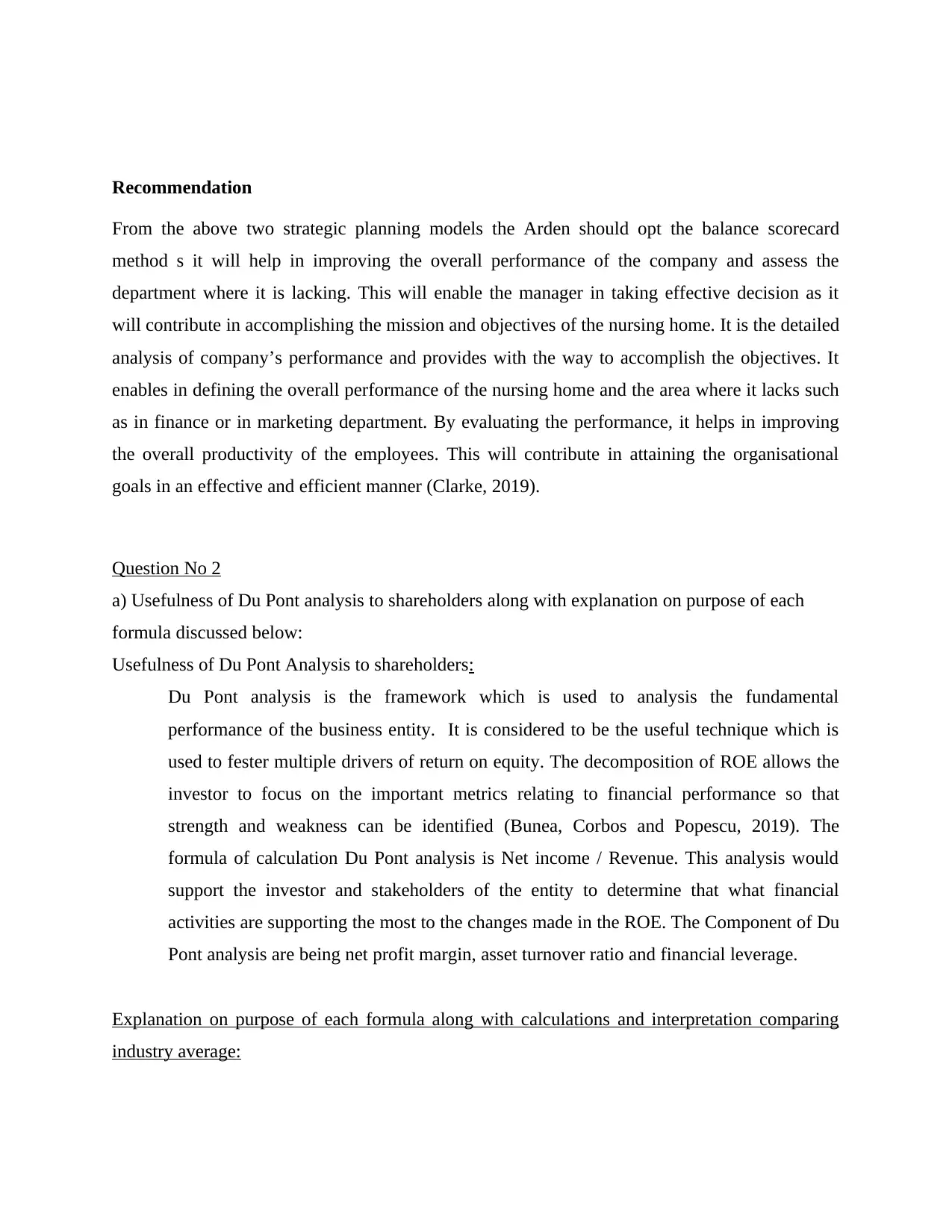
Recommendation
From the above two strategic planning models the Arden should opt the balance scorecard
method s it will help in improving the overall performance of the company and assess the
department where it is lacking. This will enable the manager in taking effective decision as it
will contribute in accomplishing the mission and objectives of the nursing home. It is the detailed
analysis of company’s performance and provides with the way to accomplish the objectives. It
enables in defining the overall performance of the nursing home and the area where it lacks such
as in finance or in marketing department. By evaluating the performance, it helps in improving
the overall productivity of the employees. This will contribute in attaining the organisational
goals in an effective and efficient manner (Clarke, 2019).
Question No 2
a) Usefulness of Du Pont analysis to shareholders along with explanation on purpose of each
formula discussed below:
Usefulness of Du Pont Analysis to shareholders:
Du Pont analysis is the framework which is used to analysis the fundamental
performance of the business entity. It is considered to be the useful technique which is
used to fester multiple drivers of return on equity. The decomposition of ROE allows the
investor to focus on the important metrics relating to financial performance so that
strength and weakness can be identified (Bunea, Corbos and Popescu, 2019). The
formula of calculation Du Pont analysis is Net income / Revenue. This analysis would
support the investor and stakeholders of the entity to determine that what financial
activities are supporting the most to the changes made in the ROE. The Component of Du
Pont analysis are being net profit margin, asset turnover ratio and financial leverage.
Explanation on purpose of each formula along with calculations and interpretation comparing
industry average:
From the above two strategic planning models the Arden should opt the balance scorecard
method s it will help in improving the overall performance of the company and assess the
department where it is lacking. This will enable the manager in taking effective decision as it
will contribute in accomplishing the mission and objectives of the nursing home. It is the detailed
analysis of company’s performance and provides with the way to accomplish the objectives. It
enables in defining the overall performance of the nursing home and the area where it lacks such
as in finance or in marketing department. By evaluating the performance, it helps in improving
the overall productivity of the employees. This will contribute in attaining the organisational
goals in an effective and efficient manner (Clarke, 2019).
Question No 2
a) Usefulness of Du Pont analysis to shareholders along with explanation on purpose of each
formula discussed below:
Usefulness of Du Pont Analysis to shareholders:
Du Pont analysis is the framework which is used to analysis the fundamental
performance of the business entity. It is considered to be the useful technique which is
used to fester multiple drivers of return on equity. The decomposition of ROE allows the
investor to focus on the important metrics relating to financial performance so that
strength and weakness can be identified (Bunea, Corbos and Popescu, 2019). The
formula of calculation Du Pont analysis is Net income / Revenue. This analysis would
support the investor and stakeholders of the entity to determine that what financial
activities are supporting the most to the changes made in the ROE. The Component of Du
Pont analysis are being net profit margin, asset turnover ratio and financial leverage.
Explanation on purpose of each formula along with calculations and interpretation comparing
industry average:
Paraphrase This Document
Need a fresh take? Get an instant paraphrase of this document with our AI Paraphraser
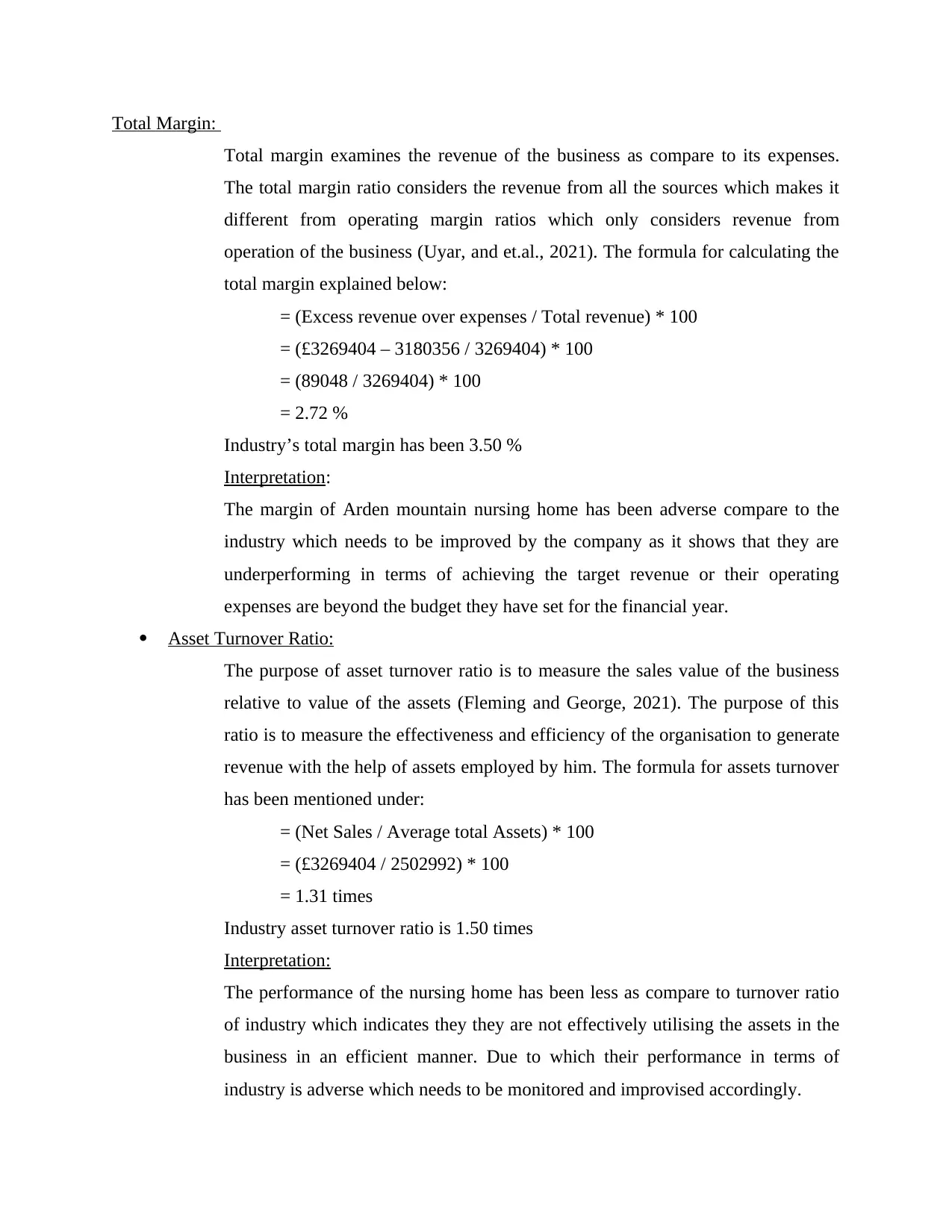
Total Margin:
Total margin examines the revenue of the business as compare to its expenses.
The total margin ratio considers the revenue from all the sources which makes it
different from operating margin ratios which only considers revenue from
operation of the business (Uyar, and et.al., 2021). The formula for calculating the
total margin explained below:
= (Excess revenue over expenses / Total revenue) * 100
= (£3269404 – 3180356 / 3269404) * 100
= (89048 / 3269404) * 100
= 2.72 %
Industry’s total margin has been 3.50 %
Interpretation:
The margin of Arden mountain nursing home has been adverse compare to the
industry which needs to be improved by the company as it shows that they are
underperforming in terms of achieving the target revenue or their operating
expenses are beyond the budget they have set for the financial year.
Asset Turnover Ratio:
The purpose of asset turnover ratio is to measure the sales value of the business
relative to value of the assets (Fleming and George, 2021). The purpose of this
ratio is to measure the effectiveness and efficiency of the organisation to generate
revenue with the help of assets employed by him. The formula for assets turnover
has been mentioned under:
= (Net Sales / Average total Assets) * 100
= (£3269404 / 2502992) * 100
= 1.31 times
Industry asset turnover ratio is 1.50 times
Interpretation:
The performance of the nursing home has been less as compare to turnover ratio
of industry which indicates they they are not effectively utilising the assets in the
business in an efficient manner. Due to which their performance in terms of
industry is adverse which needs to be monitored and improvised accordingly.
Total margin examines the revenue of the business as compare to its expenses.
The total margin ratio considers the revenue from all the sources which makes it
different from operating margin ratios which only considers revenue from
operation of the business (Uyar, and et.al., 2021). The formula for calculating the
total margin explained below:
= (Excess revenue over expenses / Total revenue) * 100
= (£3269404 – 3180356 / 3269404) * 100
= (89048 / 3269404) * 100
= 2.72 %
Industry’s total margin has been 3.50 %
Interpretation:
The margin of Arden mountain nursing home has been adverse compare to the
industry which needs to be improved by the company as it shows that they are
underperforming in terms of achieving the target revenue or their operating
expenses are beyond the budget they have set for the financial year.
Asset Turnover Ratio:
The purpose of asset turnover ratio is to measure the sales value of the business
relative to value of the assets (Fleming and George, 2021). The purpose of this
ratio is to measure the effectiveness and efficiency of the organisation to generate
revenue with the help of assets employed by him. The formula for assets turnover
has been mentioned under:
= (Net Sales / Average total Assets) * 100
= (£3269404 / 2502992) * 100
= 1.31 times
Industry asset turnover ratio is 1.50 times
Interpretation:
The performance of the nursing home has been less as compare to turnover ratio
of industry which indicates they they are not effectively utilising the assets in the
business in an efficient manner. Due to which their performance in terms of
industry is adverse which needs to be monitored and improvised accordingly.
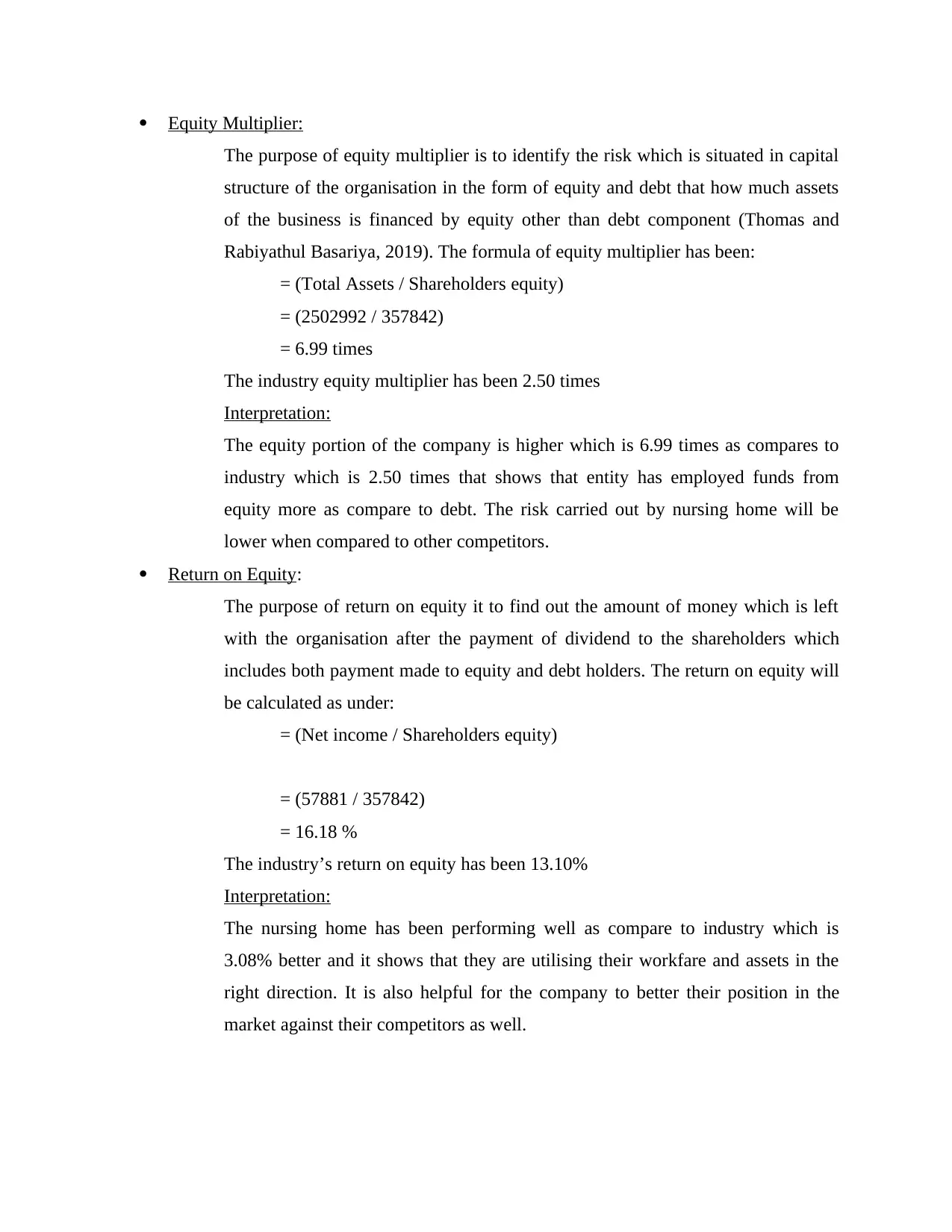
Equity Multiplier:
The purpose of equity multiplier is to identify the risk which is situated in capital
structure of the organisation in the form of equity and debt that how much assets
of the business is financed by equity other than debt component (Thomas and
Rabiyathul Basariya, 2019). The formula of equity multiplier has been:
= (Total Assets / Shareholders equity)
= (2502992 / 357842)
= 6.99 times
The industry equity multiplier has been 2.50 times
Interpretation:
The equity portion of the company is higher which is 6.99 times as compares to
industry which is 2.50 times that shows that entity has employed funds from
equity more as compare to debt. The risk carried out by nursing home will be
lower when compared to other competitors.
Return on Equity:
The purpose of return on equity it to find out the amount of money which is left
with the organisation after the payment of dividend to the shareholders which
includes both payment made to equity and debt holders. The return on equity will
be calculated as under:
= (Net income / Shareholders equity)
= (57881 / 357842)
= 16.18 %
The industry’s return on equity has been 13.10%
Interpretation:
The nursing home has been performing well as compare to industry which is
3.08% better and it shows that they are utilising their workfare and assets in the
right direction. It is also helpful for the company to better their position in the
market against their competitors as well.
The purpose of equity multiplier is to identify the risk which is situated in capital
structure of the organisation in the form of equity and debt that how much assets
of the business is financed by equity other than debt component (Thomas and
Rabiyathul Basariya, 2019). The formula of equity multiplier has been:
= (Total Assets / Shareholders equity)
= (2502992 / 357842)
= 6.99 times
The industry equity multiplier has been 2.50 times
Interpretation:
The equity portion of the company is higher which is 6.99 times as compares to
industry which is 2.50 times that shows that entity has employed funds from
equity more as compare to debt. The risk carried out by nursing home will be
lower when compared to other competitors.
Return on Equity:
The purpose of return on equity it to find out the amount of money which is left
with the organisation after the payment of dividend to the shareholders which
includes both payment made to equity and debt holders. The return on equity will
be calculated as under:
= (Net income / Shareholders equity)
= (57881 / 357842)
= 16.18 %
The industry’s return on equity has been 13.10%
Interpretation:
The nursing home has been performing well as compare to industry which is
3.08% better and it shows that they are utilising their workfare and assets in the
right direction. It is also helpful for the company to better their position in the
market against their competitors as well.
⊘ This is a preview!⊘
Do you want full access?
Subscribe today to unlock all pages.

Trusted by 1+ million students worldwide
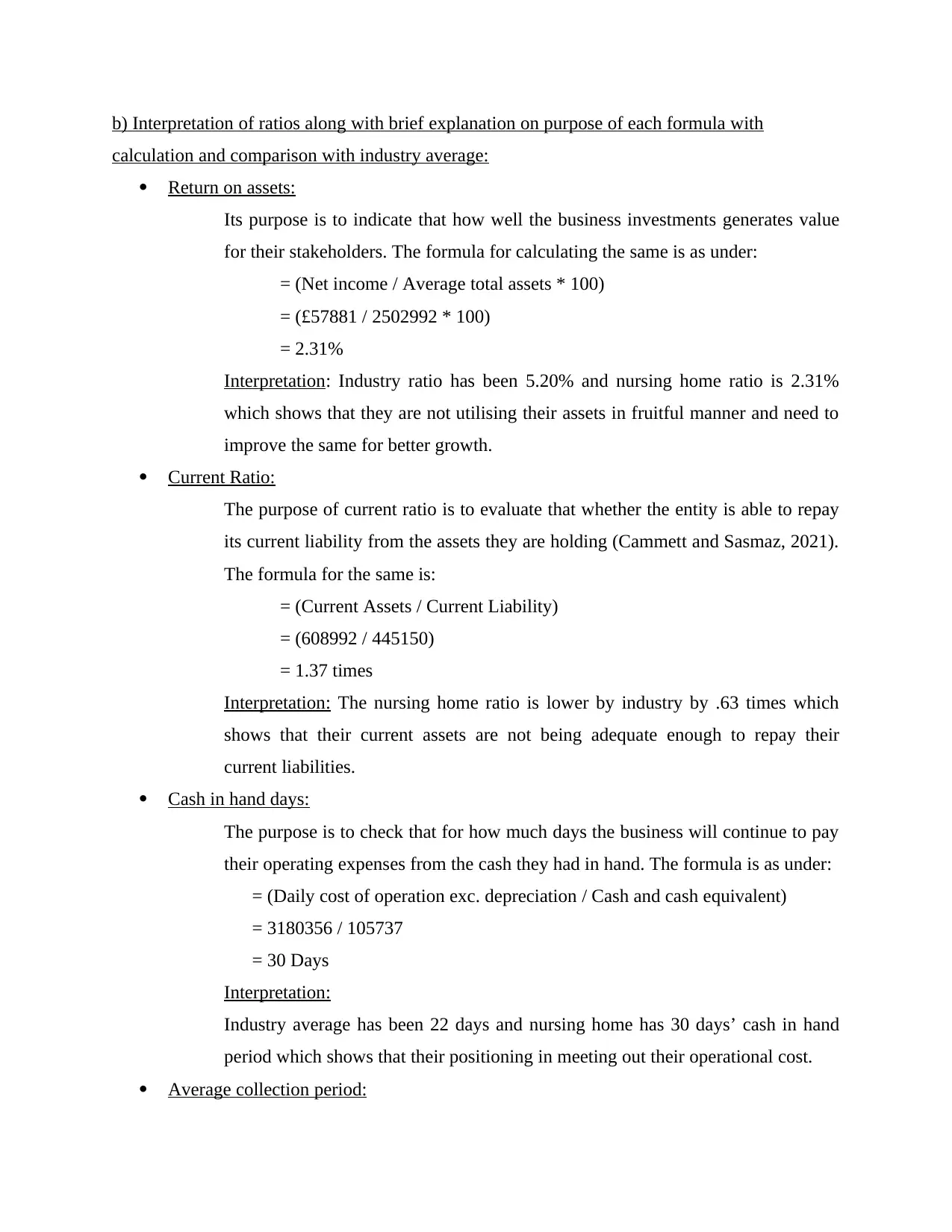
b) Interpretation of ratios along with brief explanation on purpose of each formula with
calculation and comparison with industry average:
Return on assets:
Its purpose is to indicate that how well the business investments generates value
for their stakeholders. The formula for calculating the same is as under:
= (Net income / Average total assets * 100)
= (£57881 / 2502992 * 100)
= 2.31%
Interpretation: Industry ratio has been 5.20% and nursing home ratio is 2.31%
which shows that they are not utilising their assets in fruitful manner and need to
improve the same for better growth.
Current Ratio:
The purpose of current ratio is to evaluate that whether the entity is able to repay
its current liability from the assets they are holding (Cammett and Sasmaz, 2021).
The formula for the same is:
= (Current Assets / Current Liability)
= (608992 / 445150)
= 1.37 times
Interpretation: The nursing home ratio is lower by industry by .63 times which
shows that their current assets are not being adequate enough to repay their
current liabilities.
Cash in hand days:
The purpose is to check that for how much days the business will continue to pay
their operating expenses from the cash they had in hand. The formula is as under:
= (Daily cost of operation exc. depreciation / Cash and cash equivalent)
= 3180356 / 105737
= 30 Days
Interpretation:
Industry average has been 22 days and nursing home has 30 days’ cash in hand
period which shows that their positioning in meeting out their operational cost.
Average collection period:
calculation and comparison with industry average:
Return on assets:
Its purpose is to indicate that how well the business investments generates value
for their stakeholders. The formula for calculating the same is as under:
= (Net income / Average total assets * 100)
= (£57881 / 2502992 * 100)
= 2.31%
Interpretation: Industry ratio has been 5.20% and nursing home ratio is 2.31%
which shows that they are not utilising their assets in fruitful manner and need to
improve the same for better growth.
Current Ratio:
The purpose of current ratio is to evaluate that whether the entity is able to repay
its current liability from the assets they are holding (Cammett and Sasmaz, 2021).
The formula for the same is:
= (Current Assets / Current Liability)
= (608992 / 445150)
= 1.37 times
Interpretation: The nursing home ratio is lower by industry by .63 times which
shows that their current assets are not being adequate enough to repay their
current liabilities.
Cash in hand days:
The purpose is to check that for how much days the business will continue to pay
their operating expenses from the cash they had in hand. The formula is as under:
= (Daily cost of operation exc. depreciation / Cash and cash equivalent)
= 3180356 / 105737
= 30 Days
Interpretation:
Industry average has been 22 days and nursing home has 30 days’ cash in hand
period which shows that their positioning in meeting out their operational cost.
Average collection period:
Paraphrase This Document
Need a fresh take? Get an instant paraphrase of this document with our AI Paraphraser
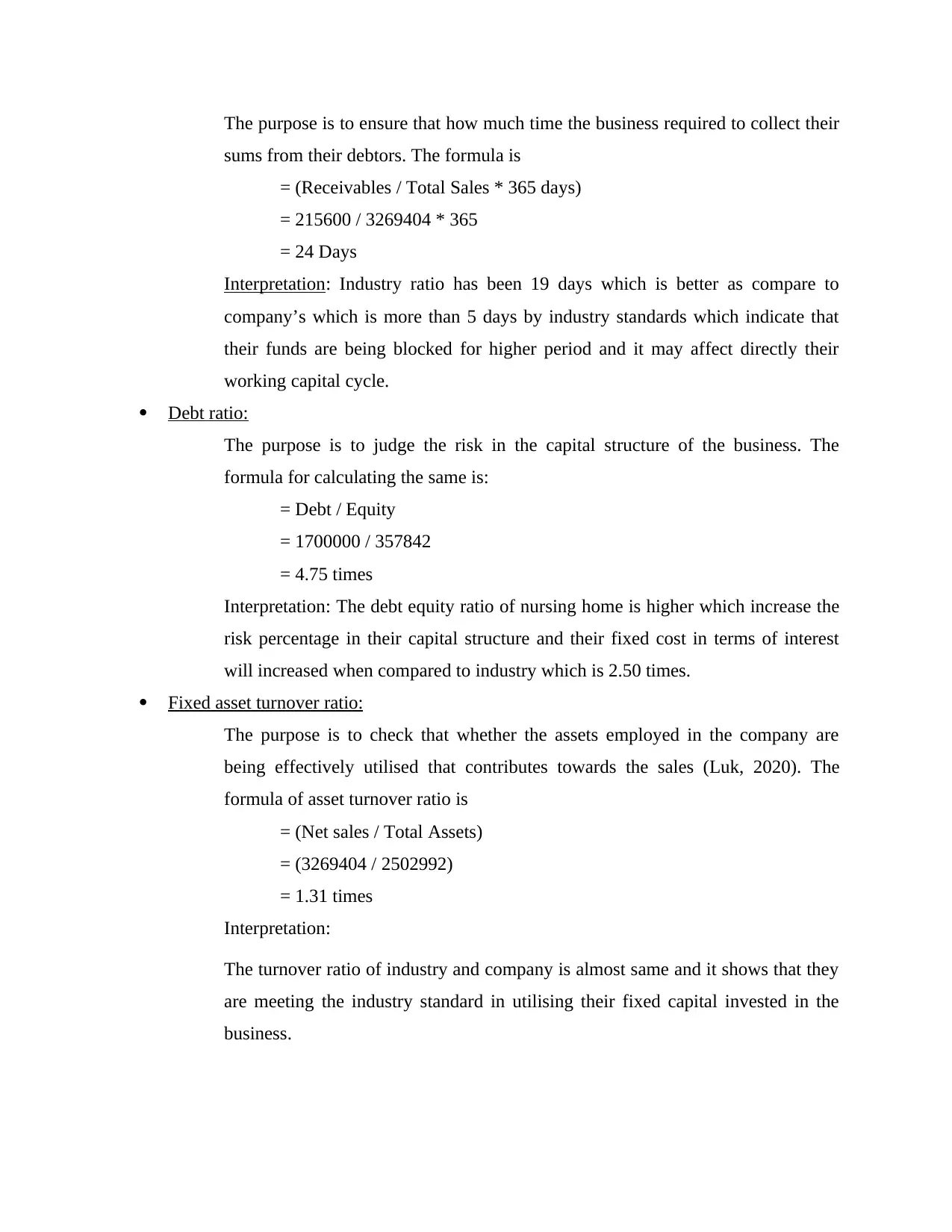
The purpose is to ensure that how much time the business required to collect their
sums from their debtors. The formula is
= (Receivables / Total Sales * 365 days)
= 215600 / 3269404 * 365
= 24 Days
Interpretation: Industry ratio has been 19 days which is better as compare to
company’s which is more than 5 days by industry standards which indicate that
their funds are being blocked for higher period and it may affect directly their
working capital cycle.
Debt ratio:
The purpose is to judge the risk in the capital structure of the business. The
formula for calculating the same is:
= Debt / Equity
= 1700000 / 357842
= 4.75 times
Interpretation: The debt equity ratio of nursing home is higher which increase the
risk percentage in their capital structure and their fixed cost in terms of interest
will increased when compared to industry which is 2.50 times.
Fixed asset turnover ratio:
The purpose is to check that whether the assets employed in the company are
being effectively utilised that contributes towards the sales (Luk, 2020). The
formula of asset turnover ratio is
= (Net sales / Total Assets)
= (3269404 / 2502992)
= 1.31 times
Interpretation:
The turnover ratio of industry and company is almost same and it shows that they
are meeting the industry standard in utilising their fixed capital invested in the
business.
sums from their debtors. The formula is
= (Receivables / Total Sales * 365 days)
= 215600 / 3269404 * 365
= 24 Days
Interpretation: Industry ratio has been 19 days which is better as compare to
company’s which is more than 5 days by industry standards which indicate that
their funds are being blocked for higher period and it may affect directly their
working capital cycle.
Debt ratio:
The purpose is to judge the risk in the capital structure of the business. The
formula for calculating the same is:
= Debt / Equity
= 1700000 / 357842
= 4.75 times
Interpretation: The debt equity ratio of nursing home is higher which increase the
risk percentage in their capital structure and their fixed cost in terms of interest
will increased when compared to industry which is 2.50 times.
Fixed asset turnover ratio:
The purpose is to check that whether the assets employed in the company are
being effectively utilised that contributes towards the sales (Luk, 2020). The
formula of asset turnover ratio is
= (Net sales / Total Assets)
= (3269404 / 2502992)
= 1.31 times
Interpretation:
The turnover ratio of industry and company is almost same and it shows that they
are meeting the industry standard in utilising their fixed capital invested in the
business.
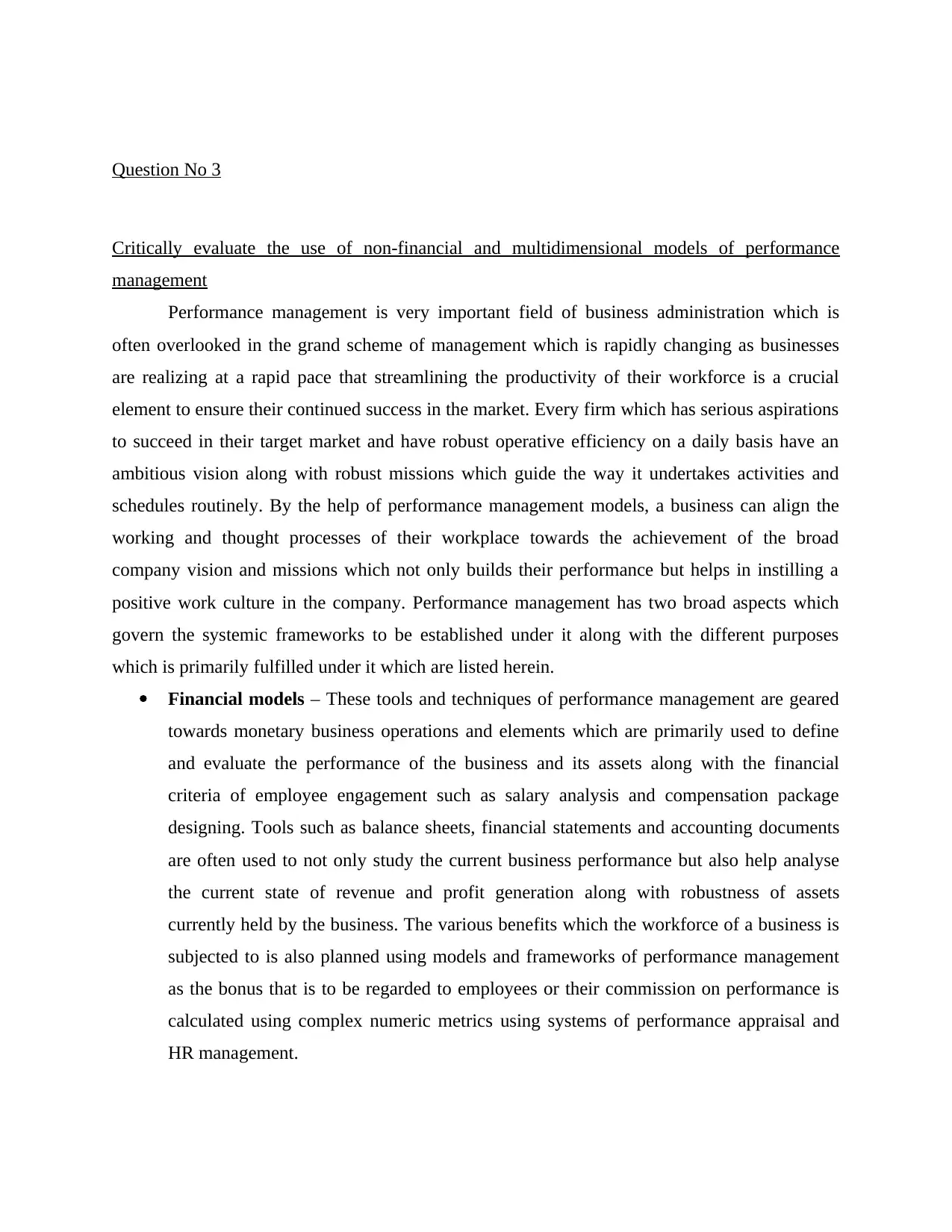
Question No 3
Critically evaluate the use of non-financial and multidimensional models of performance
management
Performance management is very important field of business administration which is
often overlooked in the grand scheme of management which is rapidly changing as businesses
are realizing at a rapid pace that streamlining the productivity of their workforce is a crucial
element to ensure their continued success in the market. Every firm which has serious aspirations
to succeed in their target market and have robust operative efficiency on a daily basis have an
ambitious vision along with robust missions which guide the way it undertakes activities and
schedules routinely. By the help of performance management models, a business can align the
working and thought processes of their workplace towards the achievement of the broad
company vision and missions which not only builds their performance but helps in instilling a
positive work culture in the company. Performance management has two broad aspects which
govern the systemic frameworks to be established under it along with the different purposes
which is primarily fulfilled under it which are listed herein.
Financial models – These tools and techniques of performance management are geared
towards monetary business operations and elements which are primarily used to define
and evaluate the performance of the business and its assets along with the financial
criteria of employee engagement such as salary analysis and compensation package
designing. Tools such as balance sheets, financial statements and accounting documents
are often used to not only study the current business performance but also help analyse
the current state of revenue and profit generation along with robustness of assets
currently held by the business. The various benefits which the workforce of a business is
subjected to is also planned using models and frameworks of performance management
as the bonus that is to be regarded to employees or their commission on performance is
calculated using complex numeric metrics using systems of performance appraisal and
HR management.
Critically evaluate the use of non-financial and multidimensional models of performance
management
Performance management is very important field of business administration which is
often overlooked in the grand scheme of management which is rapidly changing as businesses
are realizing at a rapid pace that streamlining the productivity of their workforce is a crucial
element to ensure their continued success in the market. Every firm which has serious aspirations
to succeed in their target market and have robust operative efficiency on a daily basis have an
ambitious vision along with robust missions which guide the way it undertakes activities and
schedules routinely. By the help of performance management models, a business can align the
working and thought processes of their workplace towards the achievement of the broad
company vision and missions which not only builds their performance but helps in instilling a
positive work culture in the company. Performance management has two broad aspects which
govern the systemic frameworks to be established under it along with the different purposes
which is primarily fulfilled under it which are listed herein.
Financial models – These tools and techniques of performance management are geared
towards monetary business operations and elements which are primarily used to define
and evaluate the performance of the business and its assets along with the financial
criteria of employee engagement such as salary analysis and compensation package
designing. Tools such as balance sheets, financial statements and accounting documents
are often used to not only study the current business performance but also help analyse
the current state of revenue and profit generation along with robustness of assets
currently held by the business. The various benefits which the workforce of a business is
subjected to is also planned using models and frameworks of performance management
as the bonus that is to be regarded to employees or their commission on performance is
calculated using complex numeric metrics using systems of performance appraisal and
HR management.
⊘ This is a preview!⊘
Do you want full access?
Subscribe today to unlock all pages.

Trusted by 1+ million students worldwide
1 out of 18
Related Documents
Your All-in-One AI-Powered Toolkit for Academic Success.
+13062052269
info@desklib.com
Available 24*7 on WhatsApp / Email
![[object Object]](/_next/static/media/star-bottom.7253800d.svg)
Unlock your academic potential
Copyright © 2020–2025 A2Z Services. All Rights Reserved. Developed and managed by ZUCOL.



